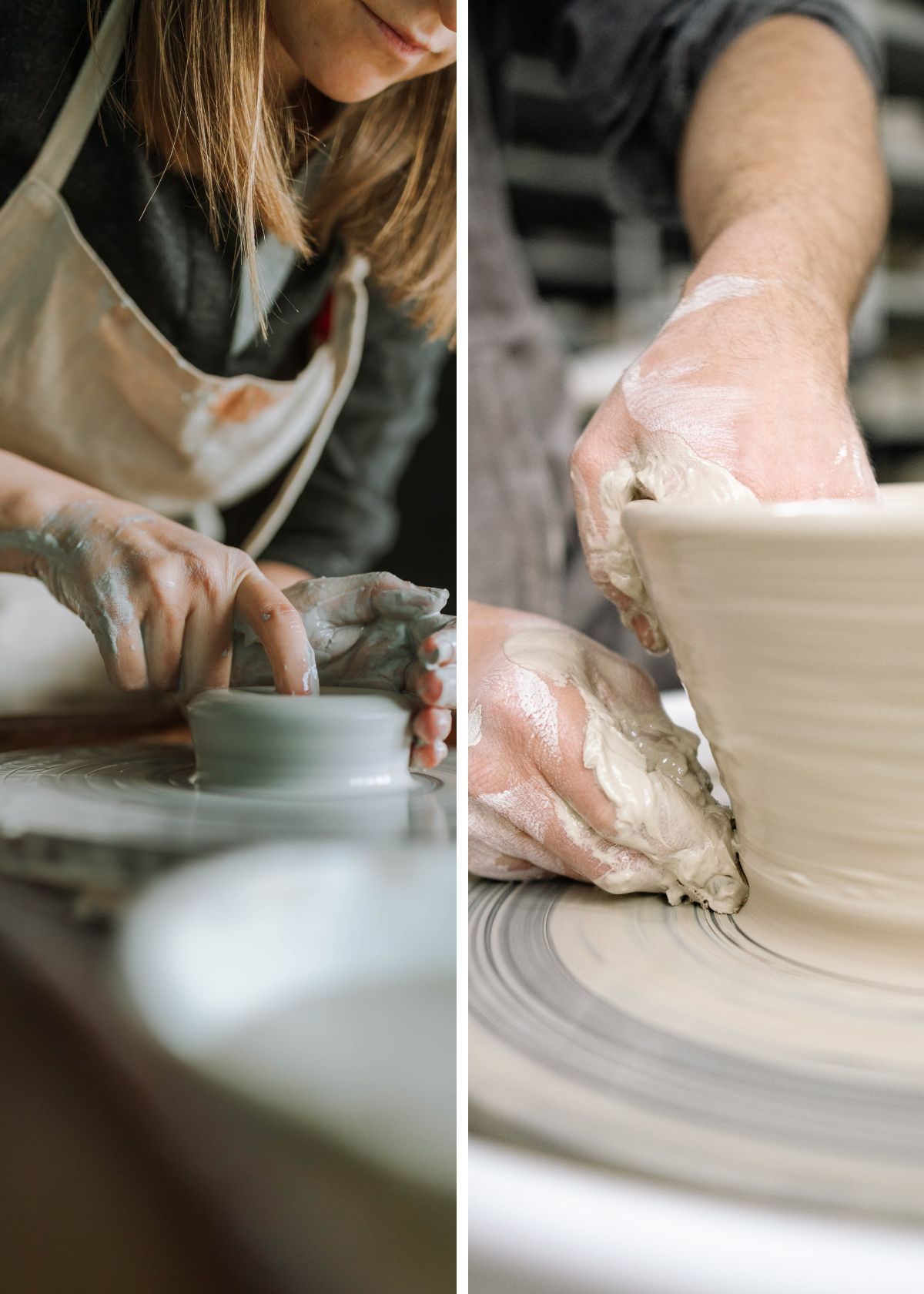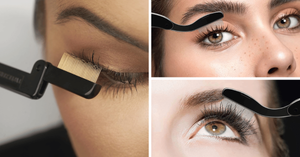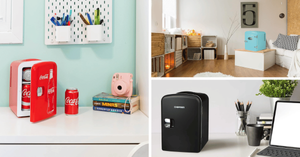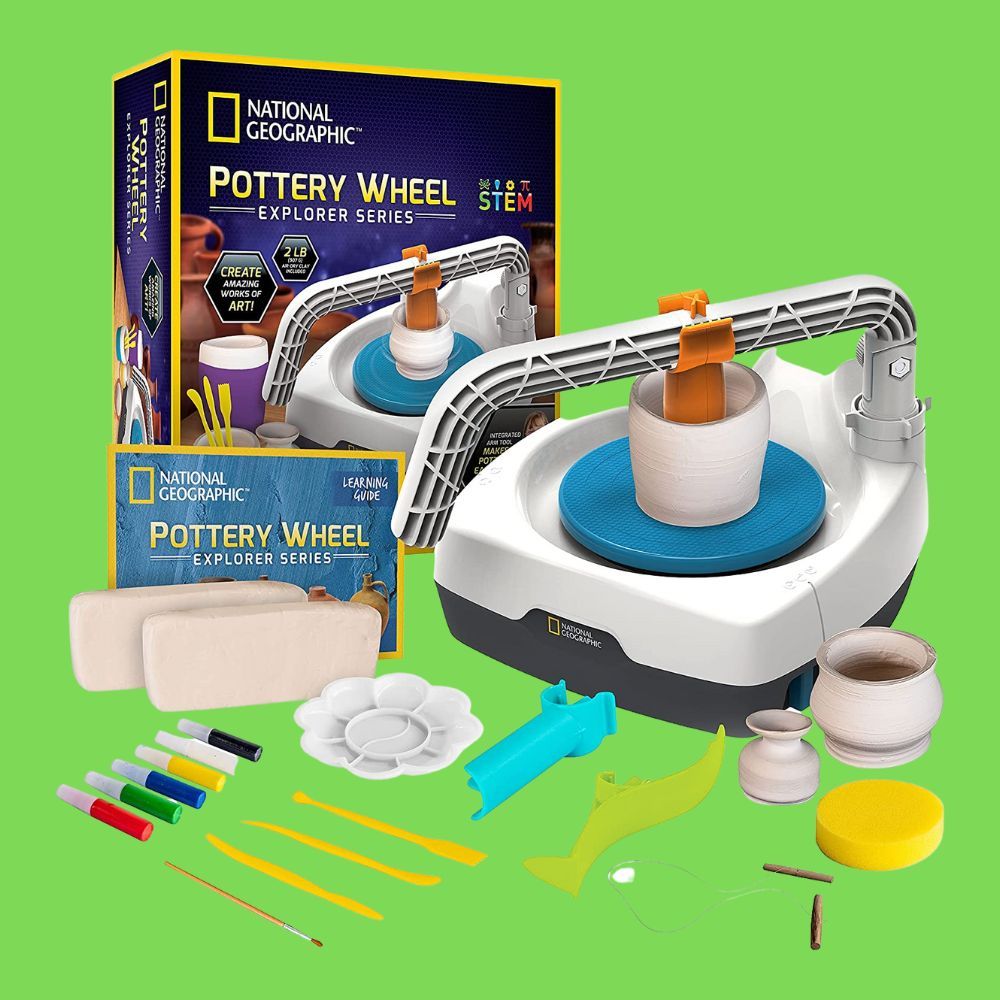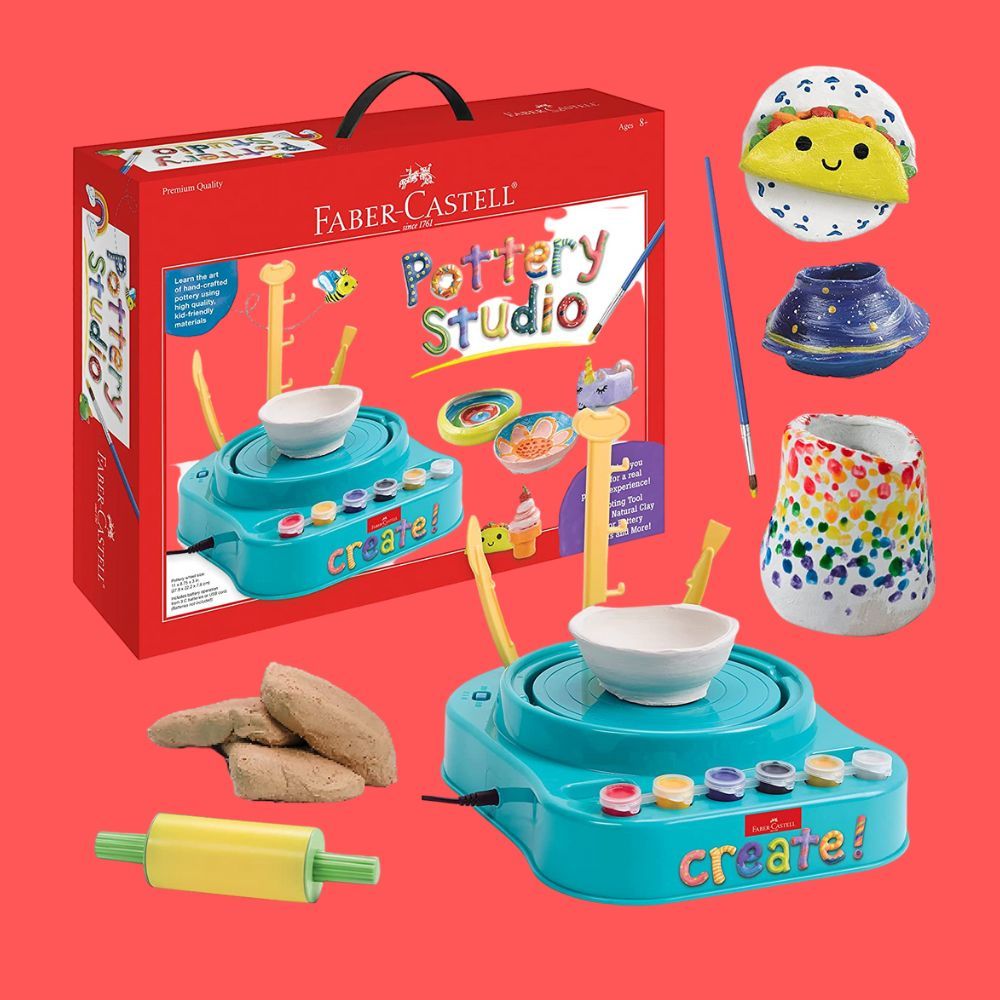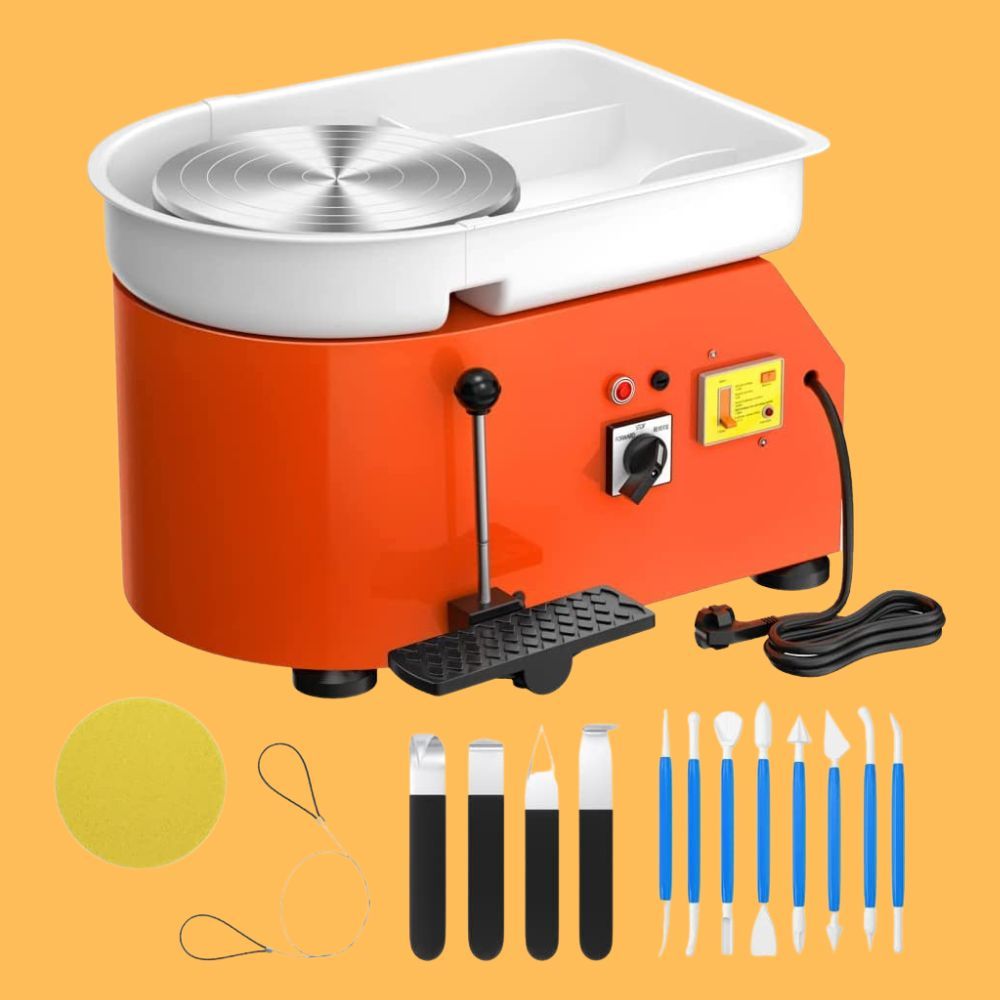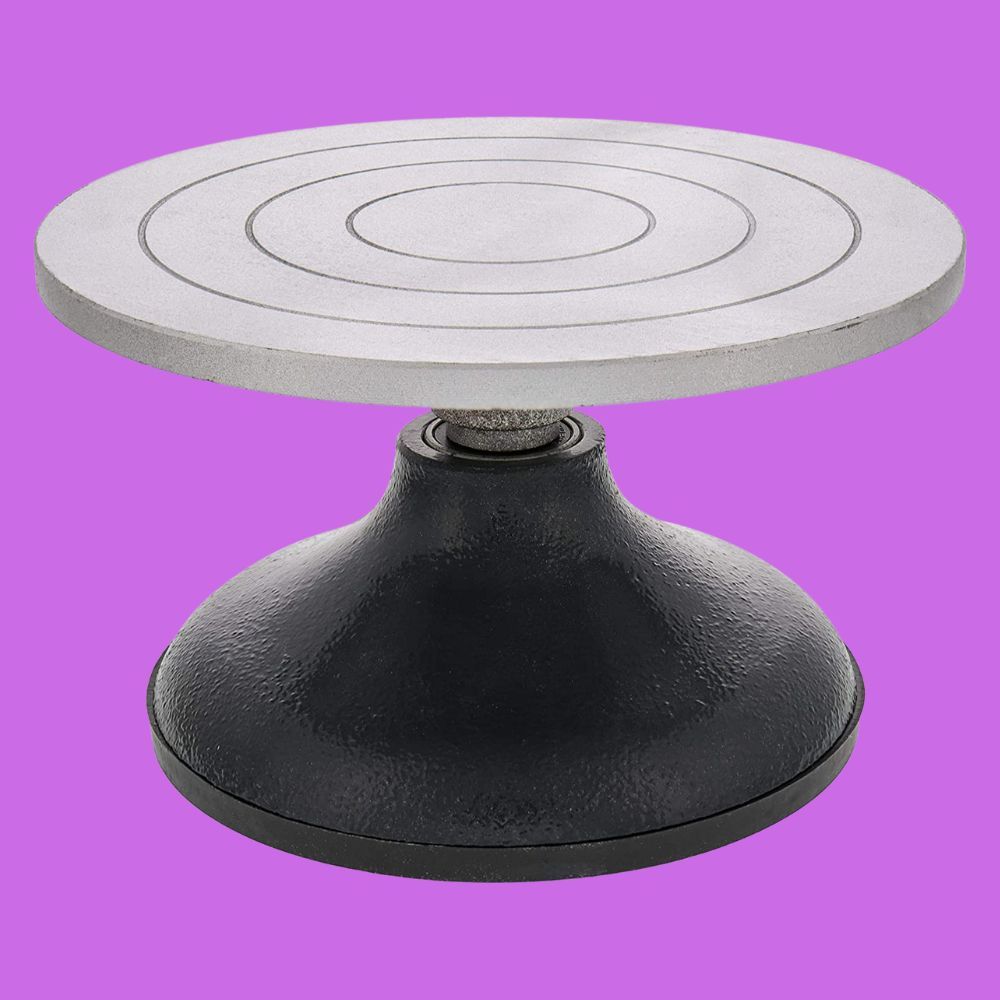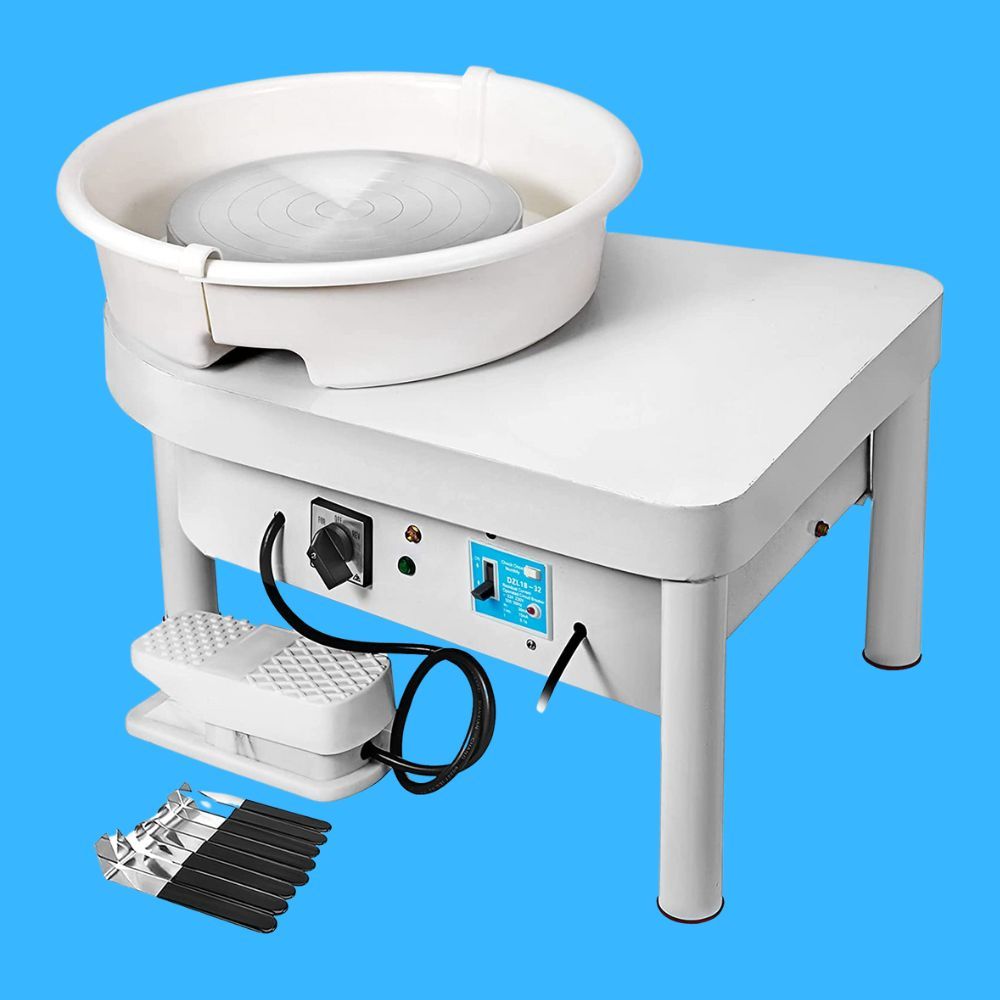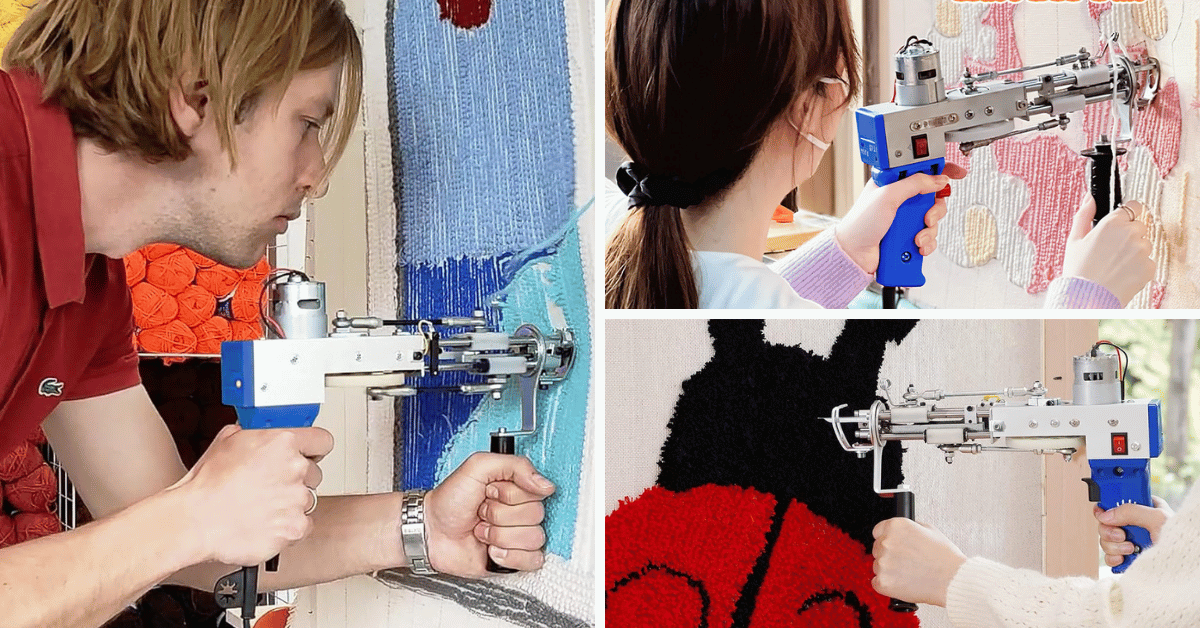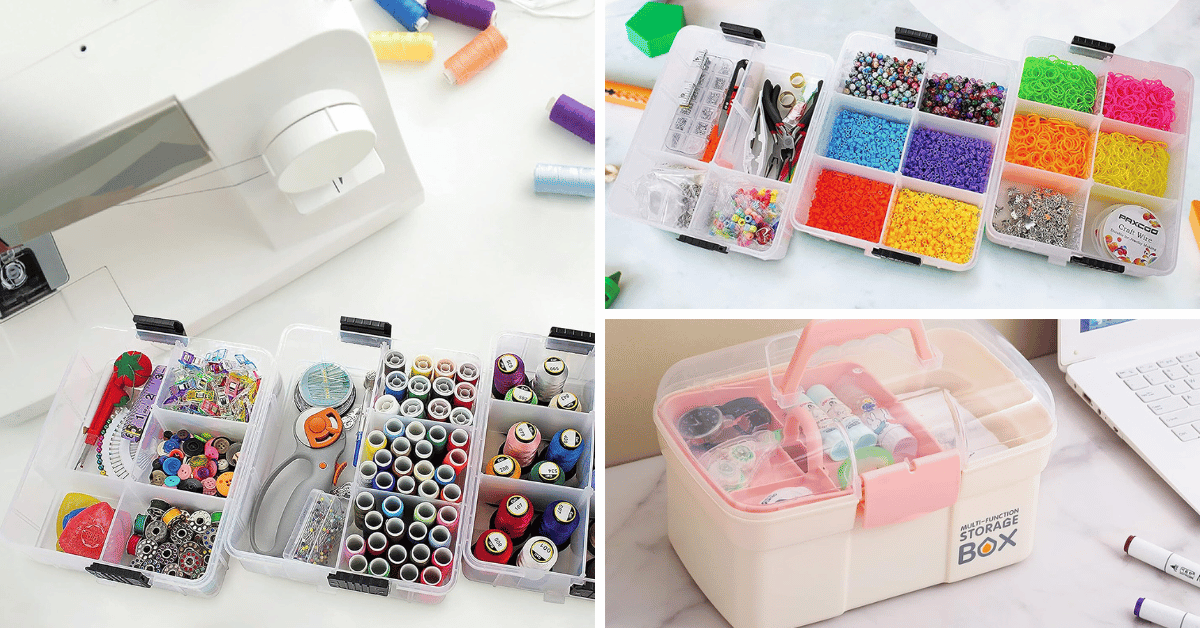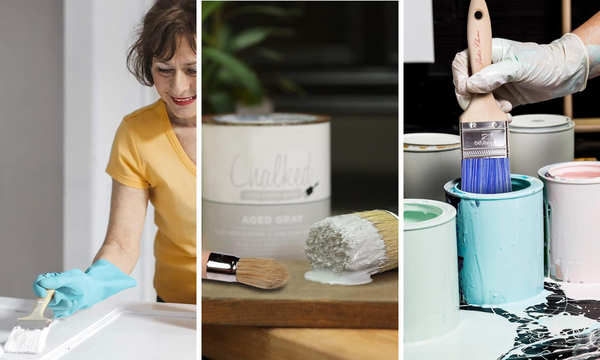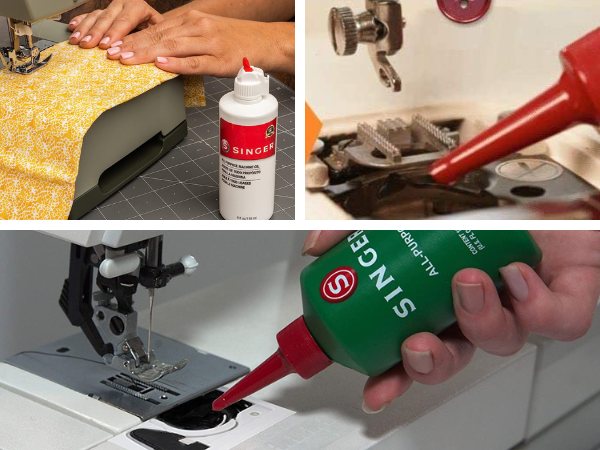Feeling creative and need an outlet?
Pottery wheel making is a great way to show your artistic side.
It's calming, peaceful, and flexes your imagination.
Plus, there are so many different types of wheels to choose from!
You're probably wondering - what's the best pottery wheel out there for me?
Look no further! We've got you covered.
How We Choose
It can be hard to know which pottery wheel is the best for your needs.
There are so many different brands and models out there!
It's no secret that choosing a pottery wheel is a big decision.
Not only do you need to consider the price, but you also need to think about how the wheel will be used.
Will it be for personal use or for a business?
After reading thousands of reviews, we've compiled a list of the 5 best pottery wheels on Amazon.
Our list includes both budget-friendly and high-end options, so you're sure to find the perfect wheel for your needs.
Wondering Why We Love It
Create your own pottery art with the NATIONAL GEOGRAPHIC Kid’s Pottery Wheel!
This set is perfect for kids of all ages to kick off their pottery journey — no previous experience needed.
It includes 2 pounds of air-dry clay, 3 arm attachments and sculpting tools, 6 paint colors, a palette and brush and an apron — giving budding potters every resource they'll need to start.
The best part?
This wheel is specially designed for beginners.
With two speeds, controlling the clay has never been easier—centering, opening and shaping are much less daunting tasks when you have your very own pottery wheel.
Plus, detailed instructions including video lessons and the illustrated learnings guide make this the perfect educational tool!
Pottery has never been so fun! Creativity abounds with the NATIONAL GEOGRAPHIC Kid’s Pottery Wheel, so don't miss out on all the life-long memories you can make with it.
Let's get spinning!
Wondering Why We Love It
Ready to tap into your inner artist and become a master potter?
Look no further than the Faber-Castell Pottery Studio!
Whether you're a beginner or an experienced pottery maker, you'll have all the tools necessary to create one-of-a-kind mugs, pinch pots, sculptures, beads and more.
Plus, this complete kit is kid friendly and comes fully assembled for a real pottery experience!
Ready for the best part?
All materials are included - that means 3lbs of air-dry clay, paint brushes, sculpting tools, white glaze for a base coat and opaque acrylic paint.
That makes it easy to pick up and start sculpting your masterpiece without gathering extra supplies.
Need help getting started?
Don't worry - you'll also find illustrated instructions teaching you how to use the pottery wheel as well as hand sculpting.
You don't need to be a Picasso in order to make something beautiful (though it doesn't hurt).
With Faber-Castell Pottery Studio it's easy and oh so fun!
So go ahead - let your imagination run wild and take your artistry skills up a notch with this amazing kit.
Wondering Why We Love It
Introducing the all-new SKYTOU Pottery Wheel Pottery Forming Machine!
This is your chance to unleash your inner artist and finally make those crisp clay vases, mugs, plates and sculptures you've been dreaming about.
With a fancy appearance and bright color, this pottery wheel machine has a sufficiently large plate of 25 cm (9.8") in diameter - giving you plenty of space to work.
It's also made with humanized design and outstanding details that will provide you with a more enjoyable mood while crafting!
Even more impressive is its compact structure and small footprint - which makes it perfect even for tighter spaces.
The ABS Removable wheel head is incredibly easy to clean too, so you don't have to worry about clogging or mud gathering in between projects.
Plus, we provide a set of shaping tools for added convenience!
Designed with an advanced high-quality brushless motor capable of reaching 0-300 rpm, this remarkable pottery wheel operates stably and with low noise.
Better yet, it also comes complete with a handle and foot pedal equipped so that the wheel rotates smoothly effortlessly -and best part?
You can switch its rotation direction as well for extra convenience.
So don't miss out on your chance to unlock your inner artist today - get the SKYTOU Pottery Wheel Pottery Forming Machine now!
Wondering Why We Love It
US Art Supply® 7” Diameter Sculpting Wheel is sure to have you sculpt like a pro in no time!
This heavy duty, nearly indestructible cast metal wheel will make all your art projects easier – from ceramics, pottery and floral arranging, to model-making, clay design and cake decorating.
The non-skid rubber boot keeps the wheel firmly in place so you can focus on your creative work.
Don't worry about having to drill holes into your workspace – this sturdy wheel has got you covered!
The unique design features concentric circles for centering your project and a weighted rim for extra momentum when spinning the top.
Plus it's tall enough (3-3/4") that you can even fit your hand right under the top while working.
With US Art Supply's 7" Diameter Sculpting Wheel, beautiful works of art made easy!
Wondering Why We Love It
Are you looking to take your expertise in pottery to the next level?
Look no further than Mophorn's Pottery Wheel.
Its gorgeous design will make all of your friends green with envy when they see it, and it won't just look good – it'll also work great.
This amazing wheel has a 25 cm (9.8") plate for sizes perfect for your projects, whatever they may be.
You can even use the foot pedal to have an effortless hands-free experience!
The compact construction ensures you can save space without compromising on performance, and its advanced high-quality brushless pottery wheel motor gives you the reliable power and speed you need for those projects requiring precision.
Plus, the detachable ABS basin is perfect for easy cleaning so that you don't have to worry about clean up time getting away from you.
And if that weren't enough, we even include a set of shaping tools so that you don't spend extra money on them.
So if you're ready to step up your game in pottery-making, then grab a Mophorn Pottery Wheel today and let your creativity flow like never before!
The Conclusion
So, if you're in the market for a pottery wheel, then you know there are a lot of different options to choose from.
With so many different brands and models out there, it can be hard to know which one is the best for your needs.
But don't worry - we've got you covered.
We've read thousands of reviews and compiled a list of the 5 best pottery wheels on Amazon.
Our list includes both budget-friendly and high-end options, so you're sure to find the perfect wheel for your needs.
So what are you waiting for?
Tap the check the price button below and get started on your next project!
Best Pottery Wheel FAQ
What Is The Average Cost Of A Pottery Wheel?
The average cost of a pottery wheel can vary drastically depending on your needs and the type of wheel you purchase. For those just starting out, basic electric pottery wheels start at around $200 USD for tabletop wheel models and up to $500 for more elaborate, larger models with all kinds of bells and whistles. These pottery wheel for beginners can be great for hobbyists or those who aren't sure if they want to invest in a long-term endeavor like pottery.
For serious amateurs or professional ceramicists looking to invest in an advanced model, prices range from $800-$2000 USD. Higher end models boast features such as variable speed control that can be tailored according to the type of clay being used, better counter balance and smoother rotation, adjustable legs so you don't have to worry about adjusting heavy weights when switching between different shapes or sizes of work, centrifugal force adjustable settings for faster throwing times, built-in trimmers so you don't have to hand trim every piece — just imagine how quickly projects could move along with these! With this kind of equipment comes greater longevity; it's made from quality materials that can withstand hundreds (or even thousands!) hours of use without breaking down.
Ultimately the cost will depend on what type of user is buying it — whether they're looking for something beginners level but still durable enough for occasional use or a higher end model meant as an investment into their craft. No matter what your budget is though, there are plenty of options out there ranging from less than $100 all the way up into the thousands!
Can You Do Pottery Without A Kiln?
Absolutely! You can make pottery without a kiln by utilizing coil and slab techniques. Using these methods you don't need any high heat or specialized equipment.
Coil pottery is one of the most common techniques used by non-kiln firing potters to create beautiful handmade pieces. This method involves rolling out coils of clay and building up the sides of a vessel or sculpture, essentially stacking them like pieces of bread until the desired shape is achieved. Once it's complete, leave your piece to dry naturally in air temperature until it's leather hard before glazing and painting if desired.
Slab construction is another technique commonly used in conjunction with coil to craft unique shapes that cannot be achieved through coiling alone. Slabs are thin sheets of clay cut into various shapes which join together at their edges when wet. It's like construction with Legos - each piece has its own shape but when put together they form an interesting figure with depth and contours not achievable otherwise. For example, using slab construction you could make a mug handle separate from the body which would then be joined together later on after drying and firing (although almost all good quality mugs nowadays come ready made).
Although you won't have as much control over textures or finishes as with traditional high fired stoneware, it's still possible to achieve striking results without any special equipment! With some ingenuity and practice there’s no limit to what kind of creations can be conjured up from simple handbuilding techniques such as coil & slab work - so why wait for a kiln?
Is It Hard To Learn The Pottery Wheel?
Learning how to use most pottery wheels can feel intimidating at first, but it’s actually quite easy with some simple tips and a bit of practice. That said, mastering the art of pottery takes time, patience and a commitment to practicing the craft. The key elements in learning how to use a pottery wheel are an understanding of centering clay on the wheel heads, using your hands effectively as tools for shaping your work, force control when manipulating the clay, and having proper knowledge of glazing techniques.
To begin using a pottery wheel you will want to start by understanding wheeldressing/centering. Wheeldressing is simply placing your thumb on top of the clay ball and index finger below it while applying gentle pressure from both sides until you feel contact between them -- this applies even if you’re working with pre-made slabs or coils for more intricate work! Then you will gradually apply more pressure towards the center (as if trying to kiss your index + middle fingers together) until there is an even amount of force from all directions holding up the center. It’s also important not to push too hard as that could cause cracks in fragile pieces like porcelain.
Once centered on top of the spinning wheel head is maintained (usually achieved through steadying yourself against one side), then comes your hand placement during manipulation stage: Your palms should be open, wrists slightly bent downwards and strongly held against each other so that they can cut through thicker areas without straining--similarly fingers should be spaced evenly apart along with consistent movement similar to kneading dough together or carving wood with chisels – always staying close enough where skin touches but not too tightly as that could restrict blood circulation or result in painful cramps after long hours spent throwing/working on pieces.
Practice also plays an important role here; experimenting different levels/amounts of pressure /speed rotating & pushing down during various stages helps find what works best for individual projects - whether its creating symmetrical walls all around vessel shapes or building up layers upon layers within intricate designs over time! Additionally making sure not to overwork certain parts ++ taking breaks regularly helps keep away fatigues so attention remains focused throughout entire process till completion point arrives securely + confidently! Lastly don't forget about glazing techniques which provide added richness /dimensionality into finished product; there are numerous courses available online or at local community centers teaching basics like layering two colors onto surface etcetera - given enough interest level anybody who's passionate about their art can easily learn how create amazing creations thanks modern advancements made alongside world wide web today!
Is Pottery A Cheap Hobby?
Pottery is an art form that can indeed be a very budget-friendly hobby, but it all depends on how much you’re willing to invest. When starting out, there are some basic pieces of pottery equipment that you need such as a wheel, clay and tools. Depending on the quality and brand of each item you choose, these items may cost anywhere from a few hundred dollars for the most basic set up to thousands for professional-grade equipment.
In addition to purchasing materials initially, there are also recurring costs associated with pottery including glazes and firing fees charged by studios or kilns. Glaze ranges in price from $15 per pound for simple glazes to upwards of $35 per pound for specialty glazes while studio firing fees vary greatly depending on the size and type of piece being fired. Some studios may have flat rates with discounts based off quantity while others charge based off size or time spent in the kiln so it's always important to ask questions before committing to using any one particular studio or kiln operator!
However, if you find yourself without access to expensive equipment or don't want to pay studio rates then consider trying out some alternative methods like air-drying your work instead of firing it in a kiln; this method requires far less set up/equipment making it ideal for those just starting out who might not have the resources available otherwise! There's even methods like Slab Building which use hand rollers instead of wheels - perfect for creative minds looking experiment with different techniques!
Ultimately though when considering whether Pottery is A Cheap Hobby? It really comes down what and how much you're willing invest - sure there are ways around having high initial costs (like Air Drying) but investing more upfront will give better longterm results and increased satisfaction overall which makes pottery an interesting option worth considering!
What Are 3 Types Of Potter's Wheel?
Potter’s wheels come in all shapes and sizes, so it can be overwhelming to choose one for a project. Here are three types of Potter’s wheel you should consider:
1. The Kick Wheel – This is the oldest and most traditional type of potter's wheel, consisting of an engine-driven flywheel which drives the spindle via a drive belt. It is typically made with heavy cast iron flywheels that require physical effort to operate them. With this type, you don't have the same level of precision over speed and rotation as other machines but you do get unparalleled feel and tactile feedback when using one.
2. Electric Pottery Wheel - Electric wheels provide more control over rotation wheel speed because they are electronically controlled and can reach higher speeds than kickwheels if desired. They have bats attached to their platforms for attaching clay pieces during throwing which allows for more intricate designs compared to kickwheel models that only allow bowl-shaped forms due to its single axis of movement. These are often used in classrooms or by serious ceramicists who need greater precision when crafting their works of art since they offer good accuracy without tiring out your arm from cranking up a manual wheel each time!
3. Tabletop Pottery Wheel - These smaller versions are designed specifically for those looking for portability or just starting out on their clay journey as they tend not to require any installation process like electric or kickwheels do making them ideal entry-level models or accessories when travelling or teaching classes away from your normal studio setup! As these are usually battery-operated they will generally struggle with larger pieces due to lack of power while also offering fewer features such as no bats included on its platform however these drawbacks do make tabletops perfect lightweight options suitable both indoors & outdoors!
Are Brent Pottery Wheels Good?
Absolutely! Brent pottery wheels are some of the best on the market. They have a wide range of models to choose from depending on your individual needs and skill level, making them one of the most versatile options available. Plus, they come at an affordable price point that won't break the bank.
In terms of performance and materials, Brent c pottery wheel rank highly among experienced potters. The company is renowned for using strong, durable materials in its production process—so you know it will last through years of use. Many models also feature easy-to-use functions like variable speed control and advanced foot pedal design for ultimate ease when throwing your clay creations!
The secret behind their success may be found in their customer care; people who purchase Brent products tend to enjoy fantastic customer service along with unbeatable quality parts and accessories. From helpful troubleshooting guides from technicians to timely product recall notifications—Brent offers all sorts of support so that you can continue to enjoy crafting with your wheel worry free!
Overall, Brent pottery wheels are an excellent choice for any aspiring or professional potter looking for a reliable tool that offers both quality construction and unbeatable customer service at an affordable price point!
Can You Replace A Splash Pan On A Pottery Wheel?
Yes, you can replace a splash pan on a pottery wheel. You'll need to purchase a new one that is the same size and shape as the original. Then, use a screwdriver to unscrew the old splash pan and attach the new one in its place. Finally, make sure it's securely fastened before using the wheel again.
Can You Make Pottery Without A Wheel?
Yes, you can definitely make pottery without a wheel. One of the oldest methods of making pottery is called hand building, which doesn't require a wheel at all. This technique includes methods like pinching, coiling, and slab construction. With these techniques, you can create a variety of shapes and designs that would be difficult to achieve with a wheel.
Pinching involves squeezing the clay between your fingers and thumb while coiling involves rolling out coils or ropes of clay and stacking them to build up walls. Slab construction involves rolling out flat sheets of clay and joining them together. These methods allow for more flexibility in design as compared to wheel throwing. So yes, it's not only possible but also creatively fulfilling to make pottery without a wheel.
What Clay Does Not Need A Kiln?
Air-dry clay is a type of clay that does not require a kiln for hardening. This type of clay hardens and cures at normal room temperature and once dry, it can be painted or varnished. It's perfect for simple arts and crafts projects, especially for children.
Another popular type of clay that doesn't require a kiln is oven-bake clay, also known as polymer clay. This type of clay can be hardened by baking in a conventional oven at home. Polymer clays are available in a wide variety of colors and can be used to create intricate pieces like jewelry, figurines, and home decor items.
Remember though, while these clays don't require a kiln, they're not typically as durable or resistant to water as kiln-fired clays. So the use should fit the durability requirement of your project.


